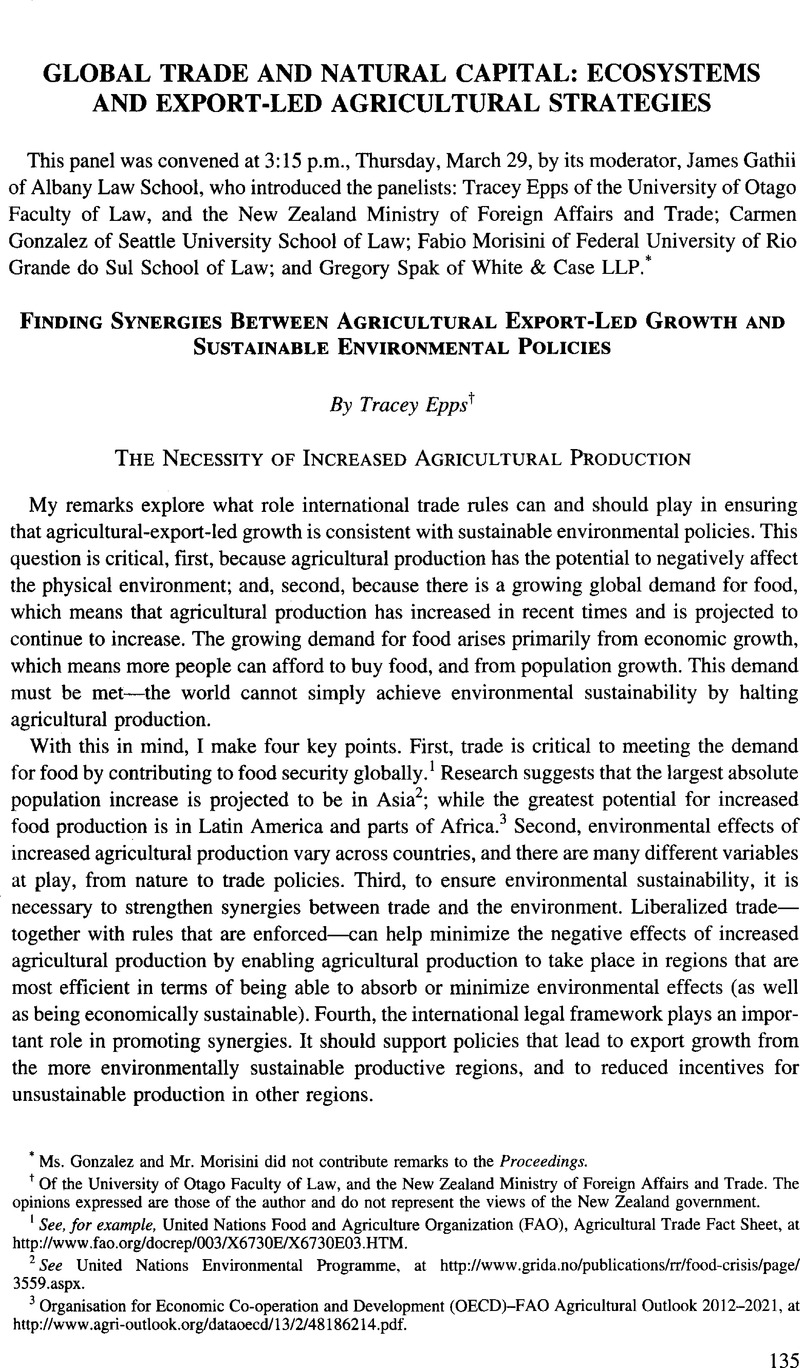No CrossRef data available.
Article contents
Finding Synergies Between Agricultural Export-Led Growth and Sustainable Environmental Policies
Published online by Cambridge University Press: 28 February 2017
Abstract

- Type
- Global Trade and Natural Capital: Ecosystems and Export-Led Agricultural Strategies
- Information
- Copyright
- Copyright © American Society of International Law 2012
References
1 See, for example, United Nations Food and Agriculture Organization (FAO), Agricultural Trade Fact Sheet, at http://www.fao.org/docrep/003/X6730FVX6730E03.HTM.
2 See United Nations Environmental Programme, at http://www.grida.no/publications/rr/food-crisis/page/3559.aspx.
3 Organisation for Economic Co-operation and Development (OECD)-Fao Agricultural Outlook 2012-2021, at http://www.agri-outlook.Org/dataoecd/13/2/48186214.pdf.
4 See Statistics New Zealand, Global New Zealand-International Trade, Investment and Travel Profile: Year Ended June 2011, at http7/www.stats.govt.nzÆrowse_for_stats/industry_sectors/imports_and_exports/global-nz-jun-11/key-points.aspx.
5 Global Trade Negotiations Home Page (Center for International Development at Harvard University), New Zealand Summary, at 1 (2004), at http://www.cid.harvard.edu/cidtrade/gov/newzealandgov.html.
6 For statistics, see the website of the New Zealand Ministry of Foreign Affairs and Trade (Trade and Economic Relations—Nz and the WTO), at http://www.mfat.govt.nz/Trade-and-Economic-Relations/NZ-and-the-WTO.index.php.
7 Global Trade Negotiations Home Page, supra note 5.
8 Adelman, David E. & Barton, John H., Environmental Regulation for Agriculture: Towards a Framework to Promote Sustainable Intensive Agriculture, 21 Stan. Envtl. L.J. 3, 3 (2002)Google Scholar.
9 Ministry of Economic Development, Greening New Zealand’s Growth—Report of the Green Growth Advisory Group, para. 5.4 (2011).
10 Id.
11 See generally Allen N. Rae & Anna Strutt, Agricultural Trade Reform and Environmental Pollution from Livestock in OECD Countries, paper presented at the Sixth Annual Conference on Global Economic Analysis, The Hague (June 12-14, 2003), at http://caps.massey.ac.nz/docs/Hague_final.pdf.
12 For a detailed discussion of types of trade policies, see Krissoff, Barry, Ballenger, Nicole, John|Dunmore & Gray, Denice, Exploring Linkages Among Agriculture, Trade, and the Environment: Issues for the Next Century 15 (U.S. Department of Agriculture, Economic Research Service, Agricultural Economic Report No. 738, 1996 Google Scholar).
13 See generally MacLeod, Catriona J. & Moller, Henrik, Intensification and Diversification of New Zealand Agriculture Since 1960: An Evaluation of Current Indicators of Land use Change, 115 AGRIC, Ecosystems & Env’t 201–18 (2006)CrossRefGoogle Scholar.
14 Rae & Strutt, supra note 11, at 14.
15 Id. at 15.
16 Krissoff et al., supra note 12, at iii (summary).
17 Arts. Xx(b), (g).
18 For a detailed discussion of environmental subsidies and the WTO, see Tracey Epps & Andrew Green, Reconciling Trade and Climate: How the WTO Can Help Address Climate Change 103-21 (2010).
19 Ministry of Economic Development, supra note 9, para. 2.9.


